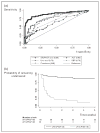Angiogenic factors in preeclampsia: potential for diagnosis and treatment
- PMID: 24076553
- PMCID: PMC3932709
- DOI: 10.1097/MNH.0b013e328365ad98
Angiogenic factors in preeclampsia: potential for diagnosis and treatment
Abstract
Purpose of review: The review summarizes new observations of key roles for circulating angiogenic factors in diagnosing, managing, and treating preeclampsia.
Recent findings: Alterations in circulating angiogenic factors (soluble fms-like tyrosine kinase-1 and placental growth factor) in preeclampsia correlate with the diagnosis and adverse outcomes, particularly when the disease presents prematurely (<34 weeks). Measurement of these angiogenic biomarkers further helps differentiate preeclampsia and its complications from other disorders that present with similar clinical profiles. A ratio of soluble fms-like tyrosine kinase-1/placental growth factor greater than 85 appears ideal as the cut-off for both diagnosis and prognosis. There is also evidence that modulating these factors has therapeutic effects, suggesting a future role for angiogenic factors in treatment and prevention of preeclampsia.
Summary: Circulating angiogenic biomarkers help in diagnostic and prognostic profiling of preeclampsia and may facilitate better management of these patients.
Conflict of interest statement
There are no conflicts of interest.
Figures

Similar articles
-
Combining Biomarkers to Predict Pregnancy Complications and Redefine Preeclampsia: The Angiogenic-Placental Syndrome.Hypertension. 2020 Apr;75(4):918-926. doi: 10.1161/HYPERTENSIONAHA.119.13763. Epub 2020 Feb 17. Hypertension. 2020. PMID: 32063058 Free PMC article. Review.
-
Circulating angiogenic factors in preeclampsia, gestational proteinuria, and preeclampsia superimposed on chronic glomerulonephritis.Am J Obstet Gynecol. 2006 Feb;194(2):551-6. doi: 10.1016/j.ajog.2005.08.034. Am J Obstet Gynecol. 2006. PMID: 16458660
-
Imbalances in circulating angiogenic factors in the pathophysiology of preeclampsia and related disorders.Am J Obstet Gynecol. 2022 Feb;226(2S):S1019-S1034. doi: 10.1016/j.ajog.2020.10.022. Epub 2020 Oct 20. Am J Obstet Gynecol. 2022. PMID: 33096092 Free PMC article. Review.
-
Changes in circulating concentrations of soluble fms-like tyrosine kinase-1 and placental growth factor measured by automated electrochemiluminescence immunoassays methods are predictors of preeclampsia.J Hypertens. 2012 Nov;30(11):2173-81. doi: 10.1097/HJH.0b013e328357c0c9. J Hypertens. 2012. PMID: 22902831
-
[Potential value of placental angiogenic factors as biomarkers in preeclampsia for clinical physicians].Nephrol Ther. 2019 Nov;15(6):413-429. doi: 10.1016/j.nephro.2018.10.005. Epub 2019 Mar 30. Nephrol Ther. 2019. PMID: 30935786 Review. French.
Cited by
-
Gold nanoparticle biodistribution in pregnant mice following intravenous administration varies with gestational age.Nanomedicine. 2021 Aug;36:102412. doi: 10.1016/j.nano.2021.102412. Epub 2021 Jun 17. Nanomedicine. 2021. PMID: 34147664 Free PMC article.
-
Maternal plasma angiogenic index-1 (placental growth factor/soluble vascular endothelial growth factor receptor-1) is a biomarker for the burden of placental lesions consistent with uteroplacental underperfusion: a longitudinal case-cohort study.Am J Obstet Gynecol. 2016 May;214(5):629.e1-629.e17. doi: 10.1016/j.ajog.2015.11.015. Epub 2015 Dec 11. Am J Obstet Gynecol. 2016. PMID: 26688491 Free PMC article.
-
Pre-eclampsia part 2: prediction, prevention and management.Nat Rev Nephrol. 2014 Sep;10(9):531-40. doi: 10.1038/nrneph.2014.103. Epub 2014 Jul 8. Nat Rev Nephrol. 2014. PMID: 25003612 Free PMC article. Review.
-
Circulating levels of angiogenic factors and their association with preeclampsia among pregnant women at Mulago National Referral Hospital in Uganda.PLoS One. 2021 May 19;16(5):e0251227. doi: 10.1371/journal.pone.0251227. eCollection 2021. PLoS One. 2021. PMID: 34010327 Free PMC article.
-
MiR-519d-3p suppresses invasion and migration of trophoblast cells via targeting MMP-2.PLoS One. 2015 Mar 24;10(3):e0120321. doi: 10.1371/journal.pone.0120321. eCollection 2015. PLoS One. 2015. PMID: 25803859 Free PMC article.
References
-
- ACOG Practice Bulletin. Diagnosis and management of preeclampsia and eclampsia Number 33, January 2002. Obstet Gynecol. 2002;99:159–167. - PubMed
-
- Ghulmiyyah L, Sibai B. Maternal mortality from preeclampsia/eclampsia. Semin Perinatol. 2012;36:56–59. - PubMed
-
- Vikse BE. Preeclampsia and the risk of kidney disease. Lancet. 2013;382:104–106. - PubMed
-
- Vikse BE, Irgens LM, Leivestad T, et al. Preeclampsia and the risk of end-stage renal disease. N Engl J Med. 2008;359:800–809. - PubMed
Publication types
MeSH terms
Substances
Grants and funding
LinkOut - more resources
Full Text Sources
Other Literature Sources
Research Materials
Miscellaneous

